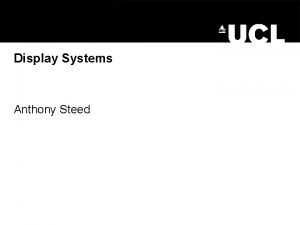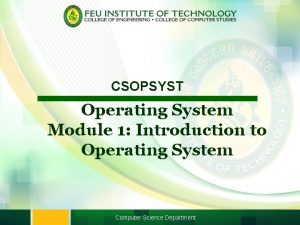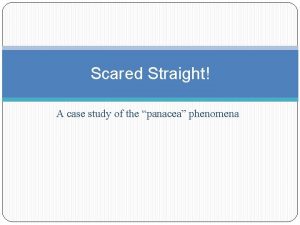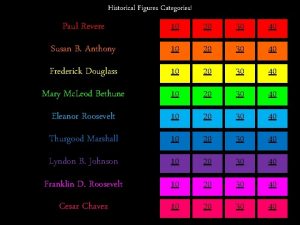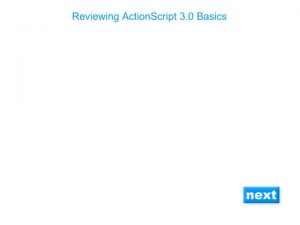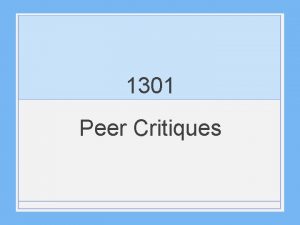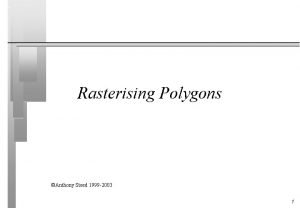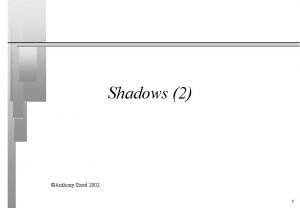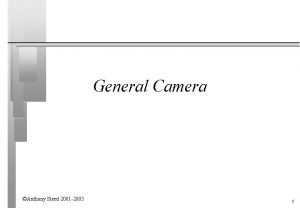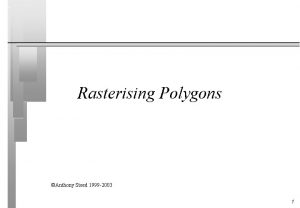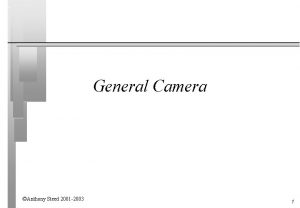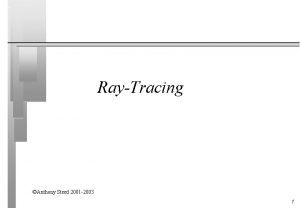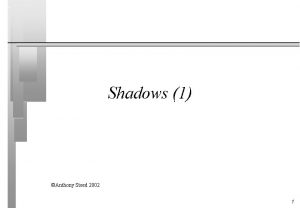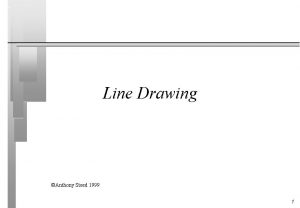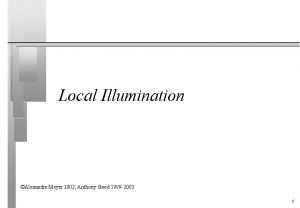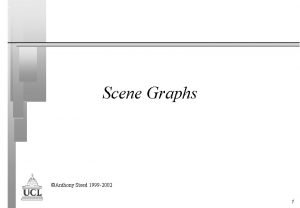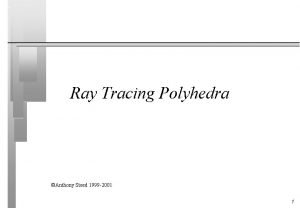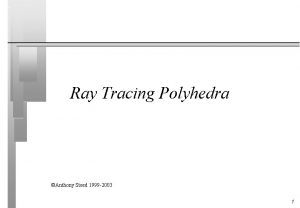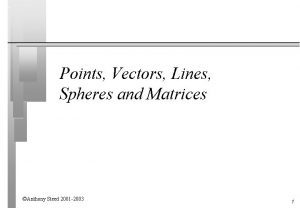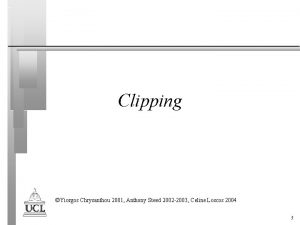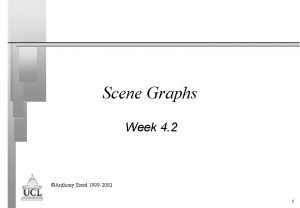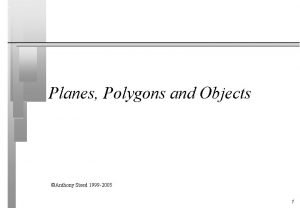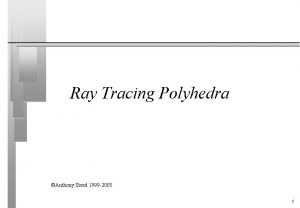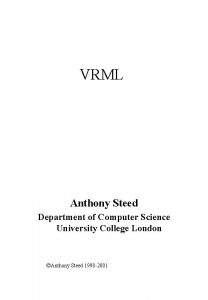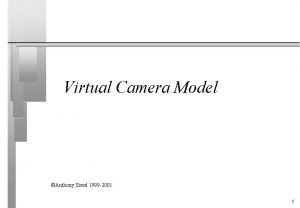Display Systems Anthony Steed Overview Critiques of Display














![Left eye Right eye Binocular percept Adapted from [Purves & Lotto] Left eye Right eye Binocular percept Adapted from [Purves & Lotto]](https://slidetodoc.com/presentation_image/527237fed21676d19409913c4c4440ef/image-15.jpg)















- Slides: 30

Display Systems Anthony Steed

Overview • Critiques of Display Technologies – Colour Gamut – Brightness & Contrast – Frame Rate • Depth Cues – Virtualisation – Cameras

CIE Chromaticity Diagram, source wikipedia

CRT Phosphor Spectrogram, source wikipedia

Brightness & Contrast • Brightness – Projectors 2000 lumens – Screen 500 candelas/m 2 – Luminance may be different for different colours • Contrast Ratio – – Ratio between black level and white 1000: 1 is good Very difficult to measure accurately Also depends on response time (time to change between any two levels)

Frame Rate • Image sources are various rates – Film at 24 Hz/96 Hz – PAL TV at 50 Hz – NTSC TV at 59. 97 Hz • Screens – CRTS have typically matched TV – Standard LCD panels up to 75 Hz – Newer panels up to 120 Hz (double NTSC/HDTV) • Projectors – CRT 120 Hz – DLP only recently matching this

Depth cues • Physiological – body has to do something in response to “reality” of the 3 D world: Doing that thing is a depth cue itself • Psychological – brain perceives some characteristics of a visual scene and infers its 3 D nature via empirical experience…baysian inference…

Levels of Virtualisation • Virtual Space – see a 3 D object when looking at something inscribed on a flat sheet – Perspective cues, lighting, shading • Virtual Image – perception of an object with depth – Stereo disparity • Virtual Environment – perception of a surrounding environment – head-slaved parallax, accommodation and vergence, surrounding display

Virtual Space Half-Life 2, Valve Software

Stereo Pairs Keystone View Company - Ruins of the Granite Temple, the Sphinx and the Great Pyramid (Oliver Wendell Holmes Stereoscopic Research Library)

Virtual Image

Virtual Environment • Requires (almost) full immersion because of the requirements for headrelated and egocentric display • At this point, user can actively explore the (visual) environment by moving naturally

Psychological Depth Cues • • Linear perspective Shading Shadows Aerial Perspective Occlusion Texture gradient Fogging

How do we see in stereo? • Binocular disparity (av. 65 mm) • Each eye has different view of same object • Perceptual fusion of 2 views (cyclopean union) of 2 viewpoints: perpn. of depth • Inputs from 2 eyes converge on the same cortical neurons in V 1 • Calculation of how different the 2 views are leads to model of depth 30 cm 6. 5 cm
![Left eye Right eye Binocular percept Adapted from Purves Lotto Left eye Right eye Binocular percept Adapted from [Purves & Lotto]](https://slidetodoc.com/presentation_image/527237fed21676d19409913c4c4440ef/image-15.jpg)
Left eye Right eye Binocular percept Adapted from [Purves & Lotto]

Physiological Depth Cues • Accommodation – Focal length of eyes adjust to focus at diff. points in scene. – Change thickness of lens: relax or tense ciliary muscles. • Convergence – Rotation of eyes inwards: view near objects – Rotation of eyes outwards (~parallel): view far objects – Powerful cue Adapted from [Slater, Steed, Chrysanthou]

Accommodation and Convergence • Usually work in conjunction with each other. • This correspondence is not physiologically determined. • Learned by experience • Is broken when looking at eg screen based stereo views.

http: //www. eleves. ens. fr: 8080/home/massimin/Images/teapot. gif

Level of Defn virtualization Cues ALL PSYCHOLOGICAL CUES: Virtual Space Linear persp. , 3 D obj. inscribed on a Shading, Shadows, flat sheet Pen & Paper + Perspective… ? ? Aerial persp. , Occlusion, Texture cues PHYSIOLOGICAL CUES Virtual Image Technology Stereoscopic Percepn. Of obj with depth disparity, Virtual Obs. slaved Environment motion parallax… “Stereoscope” 1830 s Charles Wheatstone Accomodation* Convergence* Stereo screens… All cues consistent with observer motion Cave, HMDs… ~1980 s - ‘ 90 s

Stereo Graphics Creation • Measure positions of the left and right eye • For each display surface render the image, with the field of view that matches the eye’s view of that surface • Easy in a CAVE – Image remains flat • More difficult in head-mounted displays – Image often distorted by the optics, no longer square when seen.

Setting up a stereo view Image plane Left Eye • Project diff. views of the same scene to each eye at the ~same time R 1 IPD P 1 Right Eye R 2 P 2 L 1 Stereo window Near side of image plane L 2 Adapted from [Slater, Steed, Chrysanthou] Far side of image plane • If want to present point as being in front of screen: (virtual point P 1) use L 1, R 1 • If want to present point as being behind screen: (P 2) use L 2, R 2 • Points L 1 & R 1 are homologous: same point in image space

Setting up a stereo view: Parallax 0. 0 Left Eye • IF: R-L > 0 : (P 2) R 1 IPD P 1 Right Eye L 2 R 2 P 2 • IF: R-L < 0 : (P 1) L 1 In front of stereo window Adapted from [Slater, Steed, Chrysanthou] Positive horizontal parallax: Points will be virtual points behind the stereo window. +ve Behind stereo window Negative horizontal parallax: Points will be virtual points in front of the stereo window.

Viewing Stereo pairs – what does it mean for your eyes? • Parallel setup: Left Eye R 1 IPD P 1 Right Eye L 2 R 2 Crosse d set up Parallel set up • Crossed setup: L 1 In front of stereo window Adapted from [Slater, Steed, Chrysanthou] – Right eye sees Right image, – Left eye sees left image – Requires focus beyond the images Behind stereo window – Right eye sees left image – Left eye sees right image – Requires crossing eyes • Viewing the opposite way around will reverse the sense of depth.

Presenting 3 D images: Ideals • Congruence L &R images should be same (except as caused by the horizontal parallax) Esp. colour & brightness same for homologous points • Vertical parallax -> Zero (If>0, uncomfortable to fuse images) • Parallax (view separation) trade off… Wide parallax: good depth, but too wide leads to discomfort. Parallax should be less <= IPD Closer the homologous points…less disparity between convergence & accomodation To provide max. depth but lowest parallax: Place principal objects so that ~½ parallax values are +ve, ½ -ve

CAVE-style Displays • Screens surround the user • Modelled as a series of cameras, two per wall • Each camera defined by corners of the wall and centre of eye

CAVE Projection X Y (out of screen) Z Straight forward to show that: Adapted from [Cruz-Neira et al]

Cruz-Neira et al. ’s Discussion • Advantages of a CAVE – – – Wide field of view Less rotational instability See yourself Higher quality images Less optical distortion

Cruz-Neira et al. ’s Discussion • Disadvantages – Expensive and complex to configure • Need to align several projectors • Very high refresh rate needed (>100 Hz) – – User occludes the screen with their own body Other users can occlude screen Floor shadows Typically 4 walls

Summary • Current display technology is limited – Colour, brightness, frame-rate, contrast • However 3 D computer graphics is very successful • Brain uses a variety of cues – Physiological – Psychological • Properly configured immersive systems portary robust illusions of objects

VR Systems UK
 La belle dame sans merci structure
La belle dame sans merci structure Tony steed
Tony steed Robin steed
Robin steed Simon steed
Simon steed Raster scan display and vector scan display
Raster scan display and vector scan display In random scan display the frame buffer holds
In random scan display the frame buffer holds Cathode ray tube in computer graphics
Cathode ray tube in computer graphics Distributed systems overview
Distributed systems overview Sap project system overview
Sap project system overview Introduction to distributed computing
Introduction to distributed computing I/o device management in operating system
I/o device management in operating system Operating system overview
Operating system overview Bruce entwistle
Bruce entwistle Decision support systems and intelligent systems
Decision support systems and intelligent systems Dicapine
Dicapine Embedded systems vs cyber physical systems
Embedded systems vs cyber physical systems Elegant systems
Elegant systems Edward anthony 1963
Edward anthony 1963 Edward anthony 1963
Edward anthony 1963 Beyond scared straight tony
Beyond scared straight tony Anthony delano walker
Anthony delano walker Dr unger dc
Dr unger dc Anthony johnson showalter
Anthony johnson showalter Herstelvisie anthony
Herstelvisie anthony Edward anthony method
Edward anthony method Information retrieval
Information retrieval Anthony el khoueiry
Anthony el khoueiry Anthony giddens social arv
Anthony giddens social arv Anthony petras
Anthony petras Susan b anthony
Susan b anthony Dr anthony goodman
Dr anthony goodman

